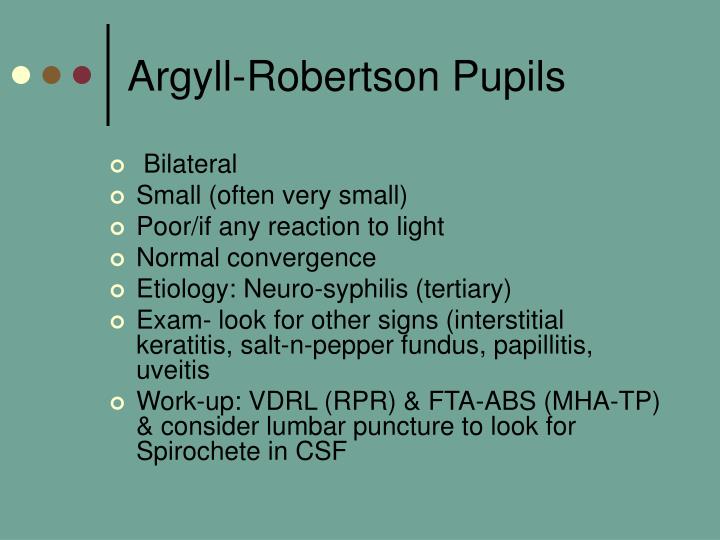
Furthermore, a lumbar puncture is suggested in all HIV patients with syphilis regardless of their presenting symptoms.ĬSF findings indicative of neurosyphilis will show greater than 20 WBC/microL, and return positive for VRDL and intrathecal pallidum antibody index.

Lumbar puncture is required in the evaluation of a patient with known syphilis presenting with these same symptoms. More commonly, however, non-treponemal blood work for VRDL (venereal disease research laboratory) or RPR (rapid plasma reagin) is sent to rule in the disease, and then confirmatory testing assessing for FTA-ABS (fluorescent treponemal antibody absorption), TPPA ( Treponema pallidum particle agglutination assay) or EIAs (syphilis enzyme immunoassays) is obtained.Ī lumbar puncture can be useful in the diagnosis of neurosyphilis in a patient with an unknown syphilis history who is presenting with neurologic and ocular disease that could be consistent with the disease. The gold standard remains visualization of spirochetes on darkfield microscopy. afferent and efferent pathways and is reliably present after 31 weeks, gestation. What do you know about the nerve pathways of the light reflex The afferent is through the optic nerve and the efferent limb is through the third cranial. Additionally globally, reports have indicated that syphilis has been on the rise in conjunction with the global HIV/AIDs epidemic. The optic nerve mediates the afferent limb of the pupillary reflex. The US CDC data estimates that 5% of MSM with syphilis are also infected with HIV. In the Argyll Robertson response, there is an absence of the pupillary light reflex with a normal.

a loss of the afferent limb of the eye blink response the trigeminal nerve. There is a high rate of co-infection with HIV in those MSM patients who have contracted syphilis. Bilateral damage to pretectal area neurons (e.g., in neurosyphilis) will produce Argyll-Robertson pupils (non-reactive to light, active during accommodation). This may be due to the fact that syphilis is more common in MSM, many of whom concurrently also have HIV, or it could reflect two separate groups with increased susceptibility. From 2000 to 2016, the rise in reported syphilis cases is primarily due to increased cases in the men who have sex with men population. The CDC acknowledges, however, that the disease is likely under-reported. Pupils will NOT constrict to light but they WILL constrict with accommodation. According to the CDC: there were 30,676 cases of late and late latent cases of neurosyphilis reported in the United States in 2016. This lesion is a hallmark of tertiary neurosyphillis. However, in the modern era, the number of cases of primary and secondary syphilis have been increasing every year since 2001, and continue to rise.

The exam finding of Argyll Robertson pupils has been rare in the developed world since the advent of penicillin in the 1940s.


 0 kommentar(er)
0 kommentar(er)
